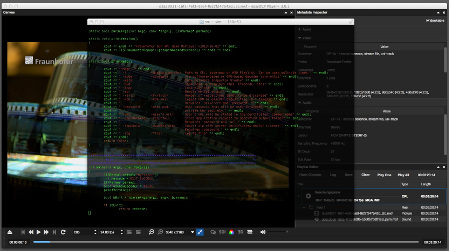What’s the Right File Format for Post-Production Content?
NUREMBURG, GERMANY—Today’s post-production professionals have many questions they must ask themselves before accepting a job: Can I process the production file format to ingest the content and additional metadata into my tool chain? How many different workflows do I have to implement to create the manifold delivery formats and to satisfy customer demands for the viewing experiences they expect, be it on the big, small or multi-screens? What other post houses do I have to involve for processing the content right way? Do I have to fine-tune the coding parameters for all different file and streaming formats? In summary, professionals are faced with hundreds of different file formats and options.

A workflow solution is in sight: The Interoperable Master Format (IMF).
You may wonder why the addition of a (n+1)th file format is a solution. Let’s start at the beginning to flesh out why.
With the advent of digital technologies, the number of formats used increased exponentially. In the past, when content was produced, just one master tape or one master film copy was created. These masters were the source for a low number of different distribution channels, essentially just 35 mm film cinema and classical TV broadcast. Today, production is much more complex.
Let’s break this down by stages of the workflow to give a clear view on why production is so much more complex.
The first step is ingestion. Production companies can select from a variety of different digital cameras, with each camera manufacturer delivering its own content source format. These capturing technologies are constantly evolving with new digital sensors with different color, bit depth and noise characteristics, thus necessitating the creation of even more source formats.
The second step is post-production. Digital technology itself allows more processing steps for color grading, compositing, versioning and special effects. Consequently, the number of involved post-production service companies increases, and data exchange amongst these facilities must occur frequently.
The professional video industry's #1 source for news, trends and product and tech information. Sign up below.
The final step is distribution. Consumer device manufacturers create their own, unique digital TV displays, smartphones or tablets to allow the best viewing experience. Devices with better reproduction technologies, higher dynamic ranges and color reproduction fidelity are on the rise. Similar to camera source formats, each of these viewing device requires its own target-specific distribution format, be it for broadcast, cinema or streaming.
This creates what seems like an endless amount of different workflows, working with a vast sea of file formats to process content from camera A to display device B, then involving production company C by using file-transfer, streaming formats, broadcast formats or cinema formats. Agreeing on, exchanging and delivering the right file format is a very complex process, wasting time and resources.
Based on these issues, the Hollywood studios initiated an effort to develop a common master exchange format for post-production: the IMF. The Entertainment Technology Center (ETC) developed the first proposal of this format in 2011, and SMPTE started its standardization immediately after. The big advantage of this format is that it is vendor neutral. It covers all the requirements of becoming a true universal master exchange format, regardless of device, distribution channel or special effects used.
The IMF contains the highest image and sound quality necessary for creating all distributions formats. It defines parameters for coding or pan and scan areas for converting into specific distribution formats by using a specification called Output Profile List (OPL). Depending on the target distribution channel and viewing device, parameters are defined by type of file format, codec used, bitrate or subtitling. Therefore, the generation of files for multi-format delivery can be automated. Manual interaction is limited to quality control.
To encourage acceptance of the IMF, a similar approach was used as with the development of the Digital Cinema Package (DCP), the worldwide standard for distribution of movies to digital cinemas. First a generally accepted file format using well-known components like MXF, JPEG2000 or XML was defined. The parameters were constrained to only include the absolutely necessary requirements and not overloaded with high flexibility, which is never used. This reduces implementation errors and results in good conformance with the standard. And last but not least, interoperability tests were executed to eliminate ambiguities and to assure error-free data exchange between different vendors.
The IMF is well on the way to replace all other exchange formats and streamline workflows. In the future, we will see the IMF evolve to continue enabling post-production professionals to seamlessly provide the viewing experiences today’s consumers have come to demand and expect through the distribution channel of their choice. This includes future adaptations for 4K, 8K, archive applications, high dynamic range (HDR) and high frame rates (HFR). With the IMF, all of the potential for immersive digital media and cinema experiences, be it brought by camera technology, special effects, or display devices, will be realized.
Dr. Foessel is Head of Department Moving Picture Technologies for Fraunhofer Institute for Integrated Circuits IIS.
